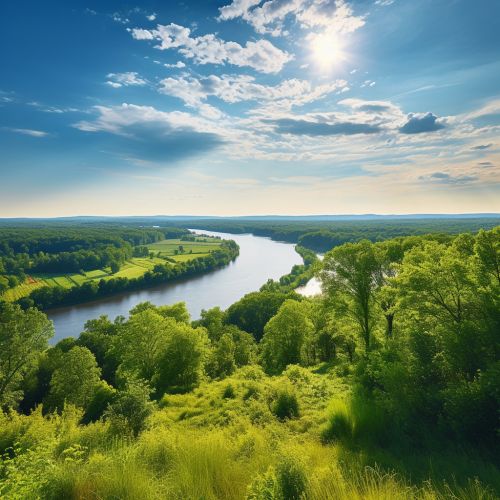Mississippi River
Geography
The Mississippi River is one of the world's major river systems in size, habitat diversity and biological productivity. It is the second longest river in North America, flowing 2,340 miles from its source at Lake Itasca through the center of the continental United States to the Gulf of Mexico.


The Mississippi River is divided into the Upper Mississippi, from its source south to the Ohio River, and the Lower Mississippi, from the Ohio to its mouth near New Orleans. The river's most distant source is the Jefferson River in Montana, the furthest stream to feed into a tributary, the Missouri River, that joins the Mississippi north of St. Louis.
Hydrology
The Mississippi's flow rate is determined by the volume of water that its tributaries carry. The largest tributary, the Missouri River, contributes about 45% of the total flow. The second and third largest contributors are the Ohio River and the Arkansas River, respectively.
The Mississippi River has a very significant effect on the climate of the United States. It is the fourth largest river in the world by volume discharge, and its drainage basin covers about 40% of the continental United States. This large drainage basin is significant in that it both moderates the river's flow and acts as a large reservoir that can hold excess water during floods.
Ecology
The Mississippi River supports a diverse range of wildlife and ecosystems. The river's aquatic and terrestrial habitats are home to numerous species of fish, birds, mammals, and reptiles, as well as countless invertebrates. The river's floodplain, known as the "batture," supports a variety of plant and animal species.
The river's natural flow has been altered by human activity, primarily through the construction of dams and levees. These alterations have had significant impacts on the river's ecology, affecting species composition, population sizes, and habitat availability.
History
The Mississippi River has played a central role in the history of the United States. Native American cultures flourished along the river for thousands of years before European exploration began in the 16th century. The river was a key transportation route during the westward expansion of the United States in the 19th century.
In the 20th century, the river became a focus for conservation efforts, as industrial pollution and habitat destruction threatened its health. Today, the river continues to be a vital resource for transportation, agriculture, and recreation, while also facing ongoing challenges related to pollution, habitat loss, and climate change.
